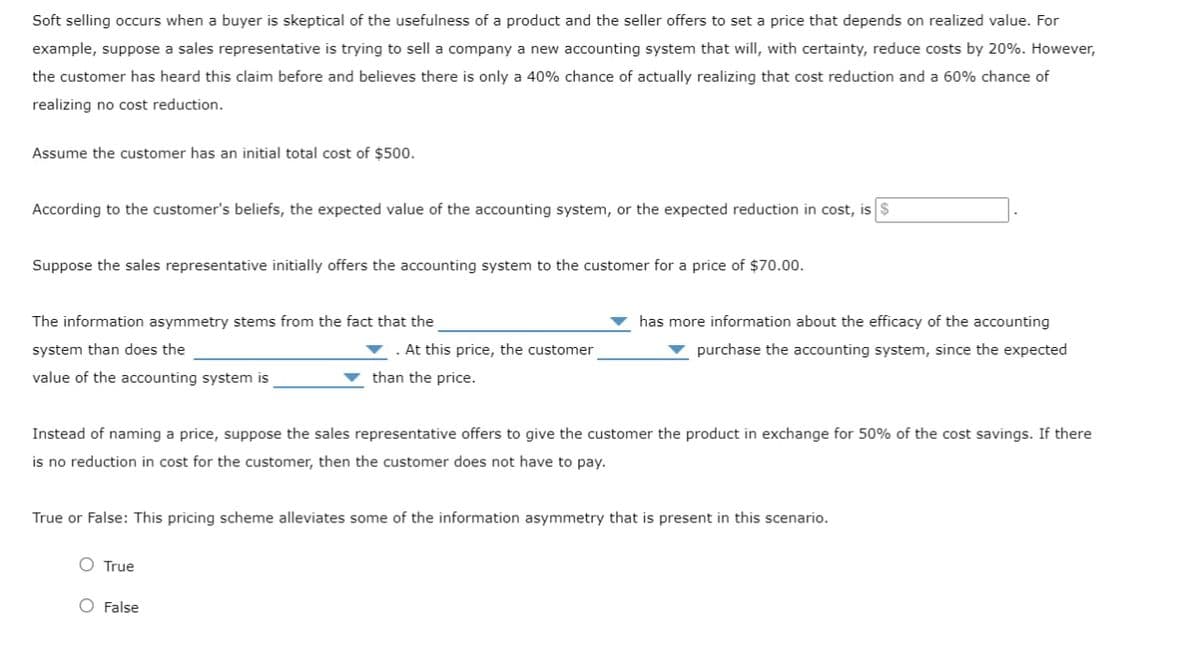Soft selling occurs when a buyer is skeptical of the usefulness of a product and the seller offers to set a price that depends on realized value. For example, suppose a sales representative is trying to sell a company a new accounting system that will, with certainty, reduce costs by 20%. However, the customer has heard this claim before and believes there is only a 40% chance of actually realizing that cost reduction and a 60% chance of realizing no cost reduction. Assume the customer has an initial total cost of $500. According to the customer's beliefs, the expected value of the accounting system, or the expected reduction in cost, is $ Suppose the sales representative initially offers the accounting system to the customer for a price of $70.00. The information asymmetry stems from the fact that the system than does the value of the accounting system is At this price, the customer than the price. Instead of naming a price, suppose the sales representative offers to give the customer the product in exchange for 50% of the cost savings. If there is no reduction in cost for the customer, then the customer does not have to pay. O True has more information about the efficacy of the accounting purchase the accounting system, since the expected True or False: This pricing scheme alleviates some of the information asymmetry that is present in this scenario. O False
Soft selling occurs when a buyer is skeptical of the usefulness of a product and the seller offers to set a price that depends on realized value. For example, suppose a sales representative is trying to sell a company a new accounting system that will, with certainty, reduce costs by 20%. However, the customer has heard this claim before and believes there is only a 40% chance of actually realizing that cost reduction and a 60% chance of realizing no cost reduction. Assume the customer has an initial total cost of $500. According to the customer's beliefs, the expected value of the accounting system, or the expected reduction in cost, is $ Suppose the sales representative initially offers the accounting system to the customer for a price of $70.00. The information asymmetry stems from the fact that the system than does the value of the accounting system is At this price, the customer than the price. Instead of naming a price, suppose the sales representative offers to give the customer the product in exchange for 50% of the cost savings. If there is no reduction in cost for the customer, then the customer does not have to pay. O True has more information about the efficacy of the accounting purchase the accounting system, since the expected True or False: This pricing scheme alleviates some of the information asymmetry that is present in this scenario. O False
Chapter18: Asymmetric Information
Section: Chapter Questions
Problem 18.5P
Related questions
Question

Transcribed Image Text:Soft selling occurs when a buyer is skeptical of the usefulness of a product and the seller offers to set a price that depends on realized value. For
example, suppose a sales representative is trying to sell a company a new accounting system that will, with certainty, reduce costs by 20%. However,
the customer has heard this claim before and believes there is only a 40% chance of actually realizing that cost reduction and a 60% chance of
realizing no cost reduction.
Assume the customer has an initial total cost of $500.
According to the customer's beliefs, the expected value of the accounting system, or the expected reduction in cost, is
Suppose the sales representative initially offers the accounting system to the customer for a price of $70.00.
The information asymmetry stems from the fact that the
system than does the
value of the accounting system is
At this price, the customer
than the price.
Instead of naming a price, suppose the ales representative offers to give the customer the product in exchange for 50% of the cost savings. If there
is no reduction in cost for the customer, then the customer does not have to pay.
O True
has more information about the efficacy of the accounting
purchase the accounting system, since the expected
True or False: This pricing scheme alleviates some of the information asymmetry that is present in this scenario.
O False
Expert Solution
This question has been solved!
Explore an expertly crafted, step-by-step solution for a thorough understanding of key concepts.
This is a popular solution!
Trending now
This is a popular solution!
Step by step
Solved in 2 steps

Knowledge Booster
Learn more about
Need a deep-dive on the concept behind this application? Look no further. Learn more about this topic, economics and related others by exploring similar questions and additional content below.Recommended textbooks for you

